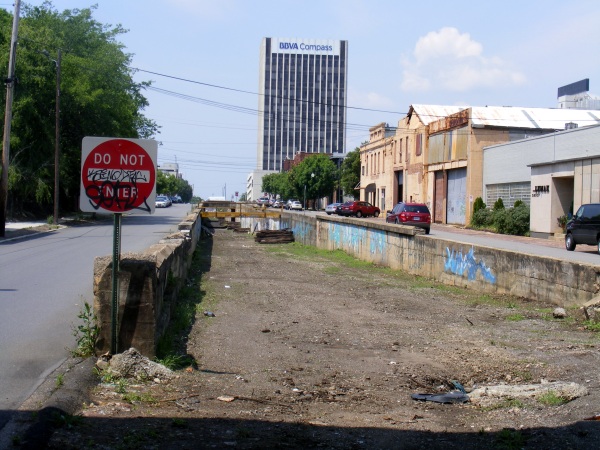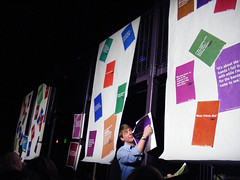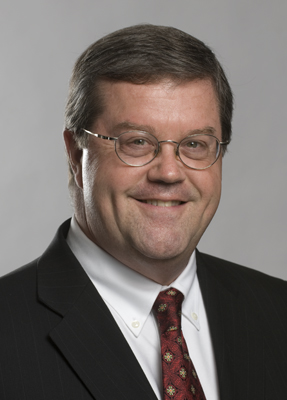 A drive along 1st Avenue South heading east contains a significant yet subtle development for those able to stop and take a look. You’ll notice the absence of rails and ties both in the area known as the 1st Avenue Cut between 20th & 24th Sts. and between 28th and 32nd Sts.
A drive along 1st Avenue South heading east contains a significant yet subtle development for those able to stop and take a look. You’ll notice the absence of rails and ties both in the area known as the 1st Avenue Cut between 20th & 24th Sts. and between 28th and 32nd Sts.
A quick look at Birmingham’s GIS map shows most of the property in question being held by CSX. If you can’t tell, I started getting that nagging feeling again (you may have seen what happened earlier this week when that starts), and for some pretty good reasons.
The parcels in question have been identified on several occasions as essential for the “Plan A” expansion of Railroad Park. This would eventually connect the existing park between 14th and 18th Streets South and the property sitting on the northwest corner of 1st Ave. S. and 18th St. that served as the focus of “Prize 2 the Future” contest to Sloss Furnaces.
The native New Yorker who reads way too many online publications from there every morning remembered the transportation company had already agreed in principal to donate the property necessary to complete the city’s High Line back in late 2011. They donated the property developed as the first segment of the park back in 2005. They also have a history of donating property across the country to recreational projects and those that focus on alternative transportation solutions. Attempts were made to hear the reason for the track removal from CSX via email last week; there has still not been a response.
It doesn’t hurt that by removing the track they’ve enabled the city to be able to claim that this project is shovel-ready for development as part of the Jones Valley Corridor. It’s considered an integral part of the Red Rock Ridge and Valley Trail System unveiled earlier this year by the Freshwater Land Trust.
This becomes significant when you realize they’re going to announce what projects across the country have been awarded TIGER grants pretty soon – even sooner than some may realize. A bid was submitted for this round to help “jump start” some area projects; it’s the second attempt to secure these federal funds to assist with the greenway initiative.
There’s also the amount of activity currently taking place close to 32nd St. and 1st Ave. S to consider. We’re anxiously awaiting more information about the upcoming groundbreaking for Sloss’ new visitors center, a project many years in the making. Those who driving by IMS‘ properties close to Sloss’ entrance notice Appleseed Workshop signs up and a significant transformation underway to make this section of town resemble the master plan the company unveiled a couple of years ago for the Sloss Business District.
When you consider the demand for the monies awarded is far exceeding the supply, the cumulative effect of all of these things happening at once suddenly gives you hope for our chances of being awarded funds. Even if it’s not awarded, there’s been a shift in momentum for this area of the city – one that’s sure to pick up steam. It’s a perfect opportunity to focus on the concept of accentuating the city positive I talked about on here a couple of years ago.
Nice, isn’t it.
André Natta is the station master for bhamterminal.com.






 When Bob Dylan’s famous lament on the nature of hypocrisy first made the charts, those of us who are now called Baby Boomers memorized all the words. Positively 4th Street pretty much laid it all bare and Dylan’s words seemed to capture what we in the 60s thought typified the hypocracy we saw all around us – in the media, in the government, in any institution with authority. What could sum up the youthful, disillusioned attitude of those watershed years better than, “You’ve got a lot of nerve to say you are my friend. When I was down, you just stood there grinning!”
When Bob Dylan’s famous lament on the nature of hypocrisy first made the charts, those of us who are now called Baby Boomers memorized all the words. Positively 4th Street pretty much laid it all bare and Dylan’s words seemed to capture what we in the 60s thought typified the hypocracy we saw all around us – in the media, in the government, in any institution with authority. What could sum up the youthful, disillusioned attitude of those watershed years better than, “You’ve got a lot of nerve to say you are my friend. When I was down, you just stood there grinning!”

Remember MAPS?
The more I did, the more I looked at the ability to point to specific accomplishments. I also thought about the issues still facing the metro region as the city begins the march towards its 150th birthday in 2021. Then I remembered a conversation I had during that 1998 visit about a yard sign I’d noticed about something called MAPS.
See, my visit to Birmingham for the tenth anniversary of City Stages in 1998 coincided with the beginning of a massive media blitz associated with the public referendum vote on the Metropolitan Area Projects Strategy legislation held on August 4 of that year. I’d try to explain it here, but the link provides a good summary of its goals. The vote was held, the initiative was defeated (except in, incidentally, the city of Birmingham), and life went on as always. Or did it?
When you start to look at the individual components of MAPS and the reasons we’ve been seeing all of this positive press, you begin to realize that time can be a valuable ally for those willing to wait, even for those who still have “The Future Can’t Wait” signs (perhaps playing off the title of a book birthed out of 1963 Birmingham). You also begin to realize just how much of our positive press can be attributed to those projects and what they encouraged.
There are some on a list maintained on BhamWiki of some of those projects listed in order of popularity based on a 1998 poll that seem to be a big reason for our recent success.
The McWane Science Center opened to the public just before the MAPS vote, meaning it was probably held up as an example of what the possibilities were for the region if the plan was approved. The major restoration of Vulcan and his home atop Red Mountain between 1999 and 2004 led to recognition by the National Trust for Historic Preservation in the form of a 2006 Preservation Honor Award.
The Birmingham Zoo did see its expansion, adding the Trails of Africa nearly 40 years after the development of a master plan that had suggested such a change. Ruffner Mountain learned this week it is included in the city council’s version of the 2014 budget as more trails are added to its more than 1,000 acres. Railroad Park anchors an emerging spine of a greenway through the heart of greater downtown. We just reported this week about the upcoming addition of the largest dog park in the city at Red Mountain Park in the city’s western area. The Red Rock Ridge and Valley Trail System hopes to tie it all together and already sees shovels in the ground.
The regional transportation hub is now called an intermodal terminal and it’s set to begin its rise next to the tracks along Morris Avenue late this year while just yesterday both this site and AL.com reported on the first major change to the law governing the BJCTA in more than 40 years. They also unveiled new buses on Thursday.
The Alabama Theatre underwent a restoration in 1998 and the community leaders are working feverishly to raise funds to finally begin restoration of the Lyric Theatre across the street. While it may not be ready in time for its 100th anniversary next year, the sight of construction crews working within will be a welcome one for those working across the street to renovate the former home of Booker T. Washington Insurance Co. into residential units.
The swimming and aquatic center got to see a track and field component added to it, resulting in the Birmingham CrossPlex in Five Points West. This is the same facility that landed the city the NCAA Division II diving, swimming, track and field, and wrestling championships this spring. Uptown is the realization of the first phase of the expanded convention center complex and entertainment district (though as Kyle Whitmire reported Thursday for AL.com, currently proposed changes to I-20/59 threaten those plans).
The 1% sales tax increase? It’s been implemented in piecemeal throughout the region in recent years (most notably – and controversially – via former mayor Larry Langford’s Birmingham Economic and Community Revitalization Ordinance in 2007, itself a mini-version of MAPS) as the need for the funding source has been realized. It is not the best approach towards raising the capital, but perhaps recent developments like the availability of a state historic tax credit for residential projects will help us see historic homes restored and occupied, leading to more property taxes being collected from a large population.
Yes, we have lost businesses and things haven’t always gone the city’s way. There is still much to be done in our outlying neighborhoods and our city center, but there are signs of progress that don’t necessarily involve waiting for elected officials to lead the way. Parking meters don’t work, sidewalks don’t exist, and lights are not always glowing at night. They must be dealt with, and soon. However, if we only dwell on those things, we’ll miss out on what has happened. Community gardens serving food deserts, signs of reinvestment in neighborhoods some wrote off. There are signs of belief in the future of the city – something I didn’t necessarily see on display in large amounts during that first visit or when I first relocated nine years ago.
Actual maps are a funny thing. They can tell you where you need to go, but they won’t always tell you about obstacles (or websites) in the way.
Most Sundays I write down the word “patience” on a prayer request card at church because I think I don’t have enough. I’d argue sometimes we don’t know what we have until it sneaks up on us – like an All-America City that still has issues to tackle, but one that’s come a long way from where it thought it would be fifteen years ago.
Just imagine if MAPS had passed? Scary, isn’t it? But we’ve still got a road map to follow, so let’s get to it. That is what’s changed – the increase in the belief in the perpetual promise of the city and the region.
André Natta is the stationmaster for bhamterminal.com.
Leave a comment
Posted in Commentary, regional